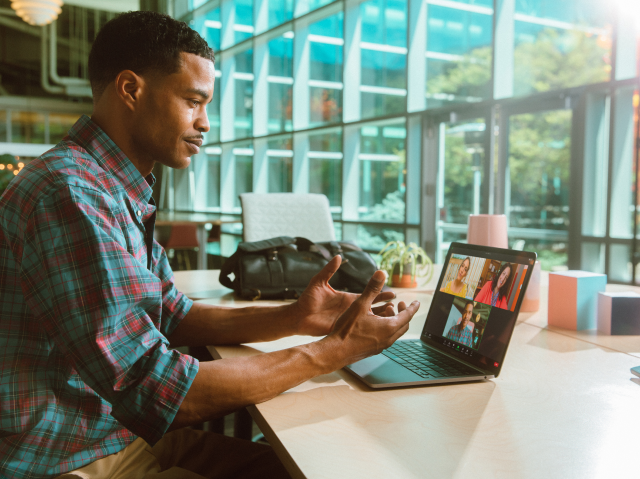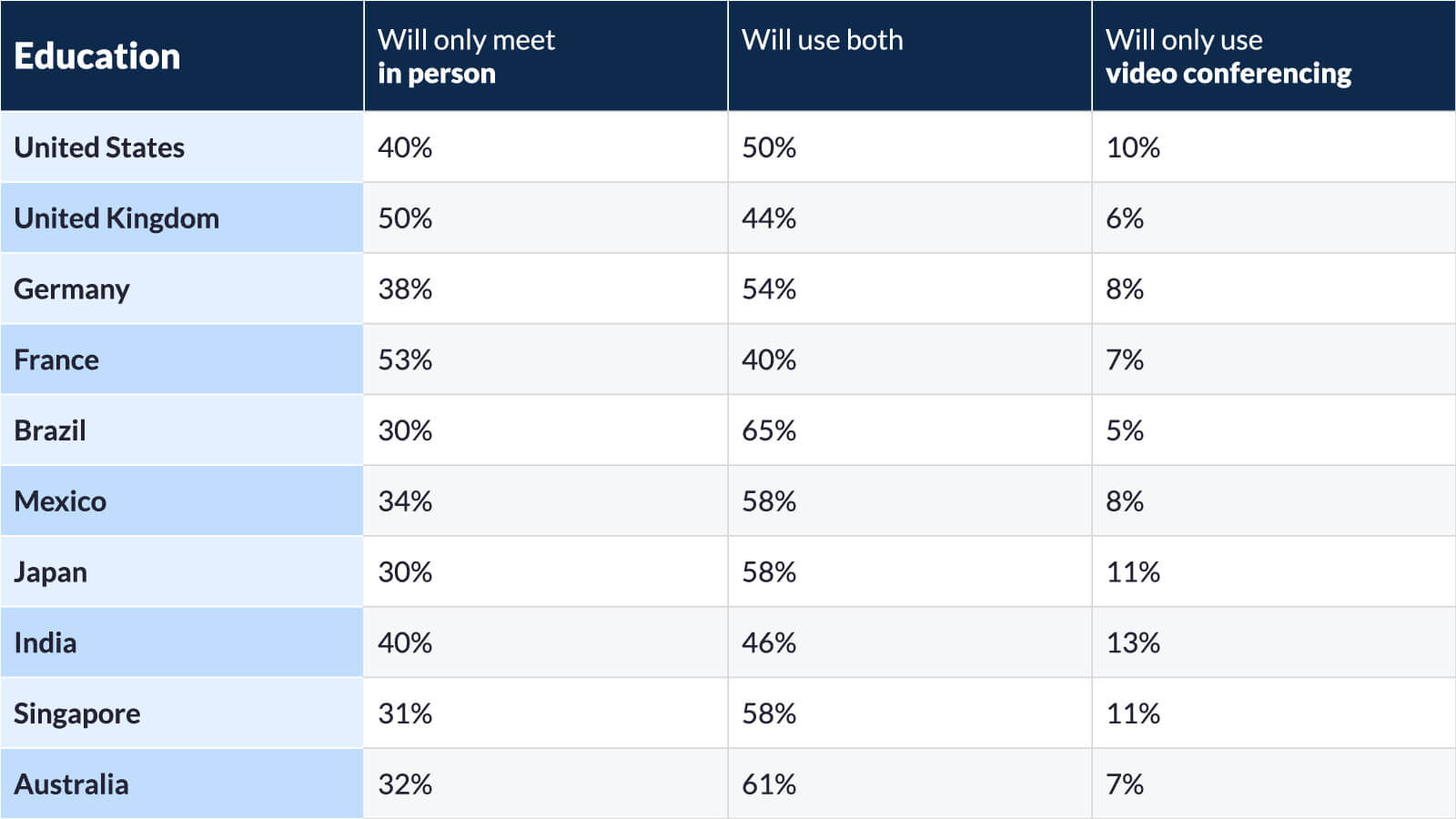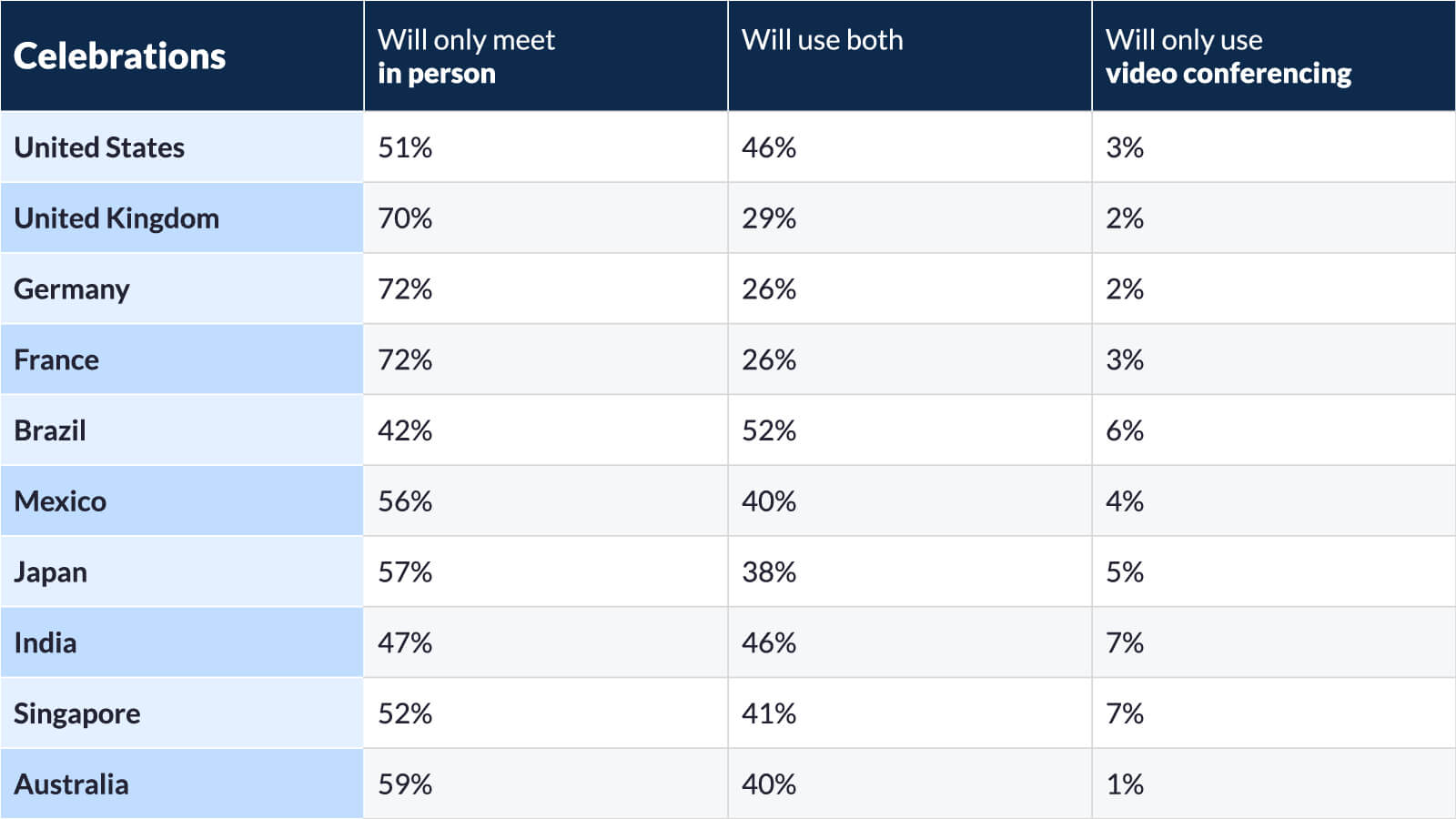We asked 7,689 people across 10 countries how they used video during the pandemic and what they wanted the post-pandemic world to look like. Here’s what they said.
How Virtual Do We Want Our Future to Be?

The COVID-19 pandemic has dramatically changed the lives and behavior of people across the globe. We have had to adapt to different ways of shopping, learning, socializing, working, celebrating, doing business, and much more.
This report, prepared and commissioned by Zoom, based on survey data and findings provided by Qualtrics Research, focuses on the impact that video communications have had on our day-to-day lives. We explored a variety of use cases for video communications and how they were used and perceived in ten different countries that spanned the globe. The survey results acknowledge the extraordinary challenges the world has faced and how video communications have helped maintain some semblance of normalcy and continuity of life’s important activities.
Although there’s been a high level of appreciation for this alternative to “in-person” living, over one year into this shift, we’re now wondering - what’s next? How much of this virtual life will we want to keep beyond the pandemic?
This report seeks to capture the current sentiment toward video communications from the perspective of everyday folks - employees, parents, students, teachers, consumers, and everyone in between.
Key takeaways
- A large majority of those surveyed believe that even after COVID-19 concerns subside, video communications are here to stay.
- Celebrations, business, and education were the activities survey respondents most frequently transitioned from in-person to virtual.
- A large majority of respondents indicated that video communications were valuable for staving off feelings of loneliness and isolation.
- A majority of respondents believe that working in a hybrid environment will allow employees to fit work around their life - and they welcome that change.
- Very few respondents think activities will be virtual-only forever. But the majority felt that our lives will include a balance of in-person and virtual components for most activities in the future.
For meetings, education, receiving medical care and information, celebrating special occasions, conducting business, and much more, we’ve really needed video communications this past year. Our survey results indicate that video conferencing was widely used for celebrations and healthcare/telehealth. But there was also broad use of video communications for music and entertainment, socializing, birthdays, holidays, conferences and events, and to keep ourselves fit and calm. By April 2020, the number of daily meeting participants on Zoom topped 300 million.
To understand the range of sentiment regarding how video communications was perceived by a cross-section of people around the world, sentiment statements were given to all respondents. They were asked if they agreed or disagreed with a particular statement. An example of this would be: Video communications can help to combat loneliness. How much do you agree or disagree with the following statement?
Sentiment Statements Asked:
1. Even after COVID-19, everything will have a virtual component in the future
A large majority from every country surveyed, when asked if they agreed or disagreed with this statement, believed that video communications are not going away.
The following chart indicates the percentage of respondents who agreed that everything will continue to have a virtual element post-pandemic:
Since the very beginning of the COVID-19 global pandemic, people around the globe who had never before been exposed to any kind of video communication experience, started to learn how to use video conferencing, mostly out of necessity. A majority of people surveyed not only use video conferencing frequently, but participate in regular video classes, holiday gatherings, doctor appointments, and work meetings without batting an eyelash. It’s not surprising that so many people can now imagine some level of virtual communication being a part of their lives moving forward.
2. Video communications can help combat loneliness
This statement garnered the highest level of agreement among respondents, with about 4 out of 5 of those surveyed agreeing that video communications offered them a level of connection to help fight feelings of isolation.
Though not caused by a virus, loneliness and isolation can have life-threatening consequences. Such risks make it worth the effort to stay connected. "Humans are social creatures by nature, so you should use the tools you have to see a loved one's face, to share stories, to let them know you're thinking of them," says Dr. Michael Craig Miller, assistant professor of psychiatry at Harvard Medical School.
Harvard Medical School Publication
Read MoreThe following chart indicates the percentage of respondents who agreed that video communications can help combat loneliness:
3. Video calling gives everyone an opportunity to participate
When asked if they agree or disagree with this statement, more than three-quarters of respondents believe that video communication offers everyone an opportunity to participate.
Being part of a meeting for any reason or occasion, gives people a sense of being included. Family and friends can join in a birthday celebration, and co-workers from different offices or on separate teams can participate at the same time and in the same virtual space without having to spend time and money on travel. Zoom accommodates up to 1,000 participants in a Zoom Meeting, with each person having the ability to speak and be seen by the entire group. That is, no doubt, a big factor for the respondents who agreed that video communication gives everyone the opportunity to engage in a meeting.
The following chart indicates the percentage of respondents who agreed that video calling gives everyone an opportunity to participate:
4. Virtual and remote activities make me feel more connected with others, especially during these times
COVID-19 hindered our ability to stay connected with friends and family. Although we weren’t able to bump into someone on the street, hang out at a friend’s house or a coffee shop, go to a backyard barbecue, or join a discussion at the water cooler, video communications offered us a way to continue to nurture our social, family, and work connections. Regular video gatherings, virtual cocktail hours, birthday celebrations, not to mention our virtual business connections, were critical to maintaining our relationships during the pandemic.
The following chart indicates the percentage of respondents who agreed that virtual and remote activities make them feel more connected with others:
5. Virtual and remote activities help improve emotional health
When asked if they agree or disagree with this statement, most respondents believed that virtual and remote activities improve emotional well-being. The connection that people feel by participating in a video call, not only helps stave off feelings of loneliness (as shown above in Sentiment Statement 1), but also positively influences our general feeling of emotional well-being.
Studies show that video calls, as opposed to phone meetings, can also be helpful for your emotional health. A 2018 study published in The American Journal of Geriatric Psychiatry looked at nearly 1,500 older adults in the U.S., who are more likely to be socially isolated, and found that using video chats to stay connected can reduce depressive symptoms by nearly 50% compared to audio and email connections.
“How Videochatting Changes Your Brain, According To Experts,” Bustle (3/26/2020)
Read MoreThe following chart indicates the percentage of respondents who agreed that virtual and remote activities help improve emotional health:
Given the extraordinary rise in video usage during the COVID-19 pandemic, it is natural to wonder if and how the level of video consumption will change when it’s safe enough to fully resume in-person gatherings and activities. Will we still want to use video conferencing? For what purposes and to what degree?
Our survey tried to capture which video use cases have been most important to you during the course of pandemic lockdowns, how video communication has helped us get through this challenging time, and how we all plan to leverage video going forward.
The study indicates that very few respondents see activities being only virtual in the future, and slightly more respondents desired an in-person-only future. The majority feel that they will have a balance of in-person and virtual activities.
Feedback from 10 countries
Here’s a snapshot of how people across the world view the role of video communications in their daily lives now and going forward.
* Note: Due to rounding, total percentages may not always equal 100%
Preference: Virtual vs. In-Person
We asked all 7,689 people across 10 countries about their current preference: If given the choice, would you prefer to do the following in-person or virtually?

For those who responded that they had used video for certain activities in the past 6 months, we asked how much they planned to continue using video for those same activities beyond the pandemic. Here’s a deeper dive into their responses.
Business
Of the survey respondents who stated that they had used video for business in the past 6 months, we followed up with this question: Thinking about the future or life after COVID-19, do you plan to attend Business-related appointments* in person or virtually?
Here’s what they said:

Summary: Hybrid working is overwhelmingly preferred to in-person-only
Most countries heavily favored a hybrid business environment, with about two-thirds of survey takers preferring a mix of virtual and in-person working environments. Many cited the fact that they didn’t have to leave their homes and could stay safer virtually, but the main downsides were the lack of a personal connection as well as a poor technical connection or other tech issue. When asked about the future of business travel, most countries expect to travel for business purposes about the same or less than they did before the pandemic.
Country-specific insights
- France and India showed a higher preference for in-person-only business appointments going forward.
- 14% of Japanese respondents and 12% of Indian respondents said they’d prefer business to be done completely virtual.
- Singapore, Brazil, and Australia showed the most enthusiasm for a future involving a mix of in-person and video communications for business.
- Respondents from Japan mostly believed business travel will look much different, with 79% expecting less travel for work going forward.
What is a hybrid workspace?
Many of the respondents’ sentiments favored a hybrid approach to business, and we wanted to be clear about what that means and what particular aspects were so appealing. We asked: Thinking about the largely virtual business environment of today, what do you imagine a hybrid workplace to look like?
Here are some of those responses:
“Now that many people have experienced home working, and companies have found that they can operate efficiently with remote working, it will become the norm and companies will be able to spend less on renting office space and overheads.”
“I think that it will be possible to choose a work style that suits each person, which will lead to the solution of the problem of children just waiting at home and the problem of turnover due to family circumstances.”
“Flexible office space for physical presence at work; more flexible physical presence working hours as much takes place digitally anyway and physical presence is not tied to the same locations through video communication.”
“It would be great! It would have everyone's safety, and mainly, it would reduce the costs of any company. Acting in a virtual way, we would have more practicality and comfort to work, helping our mental health a lot. “
“Some situations allow remote work and are even more practical. This helps to avoid coming to the workplace. We can therefore limit fuel consumption and protect the environment more.”
“We are using Zoom everyday. Zoom is a central communication tool in the company. We are really fortunate to have Zoom to help us work efficiently from home.”
Frederic De Ascencao, Head of IT, Deezer
DownloadHealthcare
Of the survey respondents who said that they had used video for healthcare or telehealth in the past 6 months, we followed up with this question: Thinking about the future or life after COVID-19, do you plan to attend Healthcare or Telehealth-related appointments* in person or virtually?
Here’s what they said:

Summary: In-person visits are here to stay, but telehealth was an added convenience
Few respondents were thrilled about solely virtual doctor appointments going forward, and many survey respondents still prefer in-person visits and exams because it felt like more of a real connection. But the convenience of telehealth was welcomed around the world, and virtual healthcare was one of the most popular video use cases in our survey. Taking routine appointments from the comfort of our own homes - as well as gaining additional access to leading specialists - will continue to be in demand.
Country-specific highlights
- Over half (52%) of respondents in France and Australia plan for their future healthcare needs to be taken care of in person only.
- In India, 13% want to only use video communication for visits going forward.
- Most countries say not having to leave their homes to see a doctor or specialist was the best part of virtual care.
“I think our patients will very much be unhappy if all of this type of care goes away now. They have come to realize the value of the approach. Before, they might have to take a day off from work and drive four hours round-trip to see their doctor for a 30-minute appointment. Now, they spend 90% of their total time with the doctor, not in traffic or waiting rooms. When they want a visit with their doctor, they feel that a virtual visit is best.”
Lee Schwamm, M.D., “A Virtual Revolution: How the COVID-19 pandemic will transform care delivery”
Read MoreEducation
Of the survey respondents who stated that they had used video for education in the past 6 months, we followed up with this question: Thinking about the future or life after COVID-19, do you plan to attend Education-related appointments* in person or virtually?
Here’s what they said:

Summary: In-person remains a priority for education but virtual has a role
The pandemic shuttered schools and upended learning all over the world, and video communications were at times the only option for safely continuing education. A top concern with virtual education was creating a real connection and fostering engagement between students, teachers, and classmates. Many respondents have a preference for in-person learning going forward, but are open to virtual when in-person is not available.
Country-specific highlights
- About 1 in 10 respondents from the United States, Japan, India, and Singapore were more receptive to virtual-only learning scenarios.
- About half of respondents in France (53%) and the United Kingdom (50%) prefer their education-related activities in-person only going forward.
- Brazil was the least likely (5% of respondents) to entertain a virtual-only education environment.
“Regardless of what 2021 looks like, we plan to have Zoom and Neat as tools in our learning spaces going forward. Neat and Zoom have allowed Ulster BOCES to leverage instructional design for what we believe teaching and learning could and should be for the future.”
Jonah Schenker, Deputy Superintendent, Ulster Board of Cooperative Educational Services
Read MoreEvents
The survey respondents who stated that they had used video for events in the past 6 months, we followed up with this question: Thinking about the future or life after COVID-19, do you plan to attend Events* in person or virtually?
Here’s what they said:

Summary: Events are best experienced in-person
Convenience and time savings were key factors for using video for events in our survey, but respondents in every country were adamant on their preference that events like concerts and religious services be in-person going forward. Virtual options were welcomed for those who needed a distraction or when in-person was not available.
Country-specific highlights
- Japan (65%) and Brazil (59%) were most for a mix of virtual and in-person events.
- 10% of India respondents would welcome virtual-only events in the future, while just 3% of those in Mexico and Brazil - and 2% in Germany - could say the same.
- Respondents in the United Kingdom were the least likely (39%) to want to attend events both virtually and in-person beyond the pandemic.
“Digital programming has worked well for us. We’re reaching more people than when we do the events inside the museum. We’re also finding that we’re getting a bigger audience nationally and internationally.”
John Echeveste, CEO at LA Plaza de Cultura y Artes
Read More2021 MozFest virtual event increases attendance 5x
In March 2021, for the first time in its 11 year history, Mozilla had to figure out how to create and produce its very popular, annual event, MozFest, as a virtual experience. Though it was a daunting task, MozFest was able to keep the creative, inclusive spirit of their gathering alive by using video communications. They used Zoom video communications to support hundreds of interactive sessions, panel discussions, and in-depth workshops.
According to Kristina Gorr, MozFest Communications Manager:
"We wanted a platform that would provide accessibility for all. We had people in our community who wanted to participate from all over the world; parts of Africa, and remote areas around the globe. Diversity and inclusion and accessibility are really important to us and every year we make a huge effort to try to improve as much as we can to enable even more people to attend. Honestly, we never would have planned an online-only event, but the global pandemic decided otherwise. Thanks to available video and audio technology, we were able to host the largest festival we've ever had! There were 9,800 people who joined us virtually for our event this March. That’s almost five times what we see at in-person festivals. That was a huge increase in our reach and accessibility … in large part thanks to Zoom.”
Celebrations
Of the survey respondents who stated that they had used video for celebrations in the past 6 months, we followed up with this question: Thinking about the future or life after COVID-19, do you plan to attend Celebrations* in person or virtually?
Here’s what they said:

Summary: Don’t expect virtual birthdays forever
Celebrations were one of the top activities that moved to virtual during the COVID-19 pandemic, but survey respondents had strong feelings on how much of these birthdays, weddings, and holidays they wanted to celebrate virtually. While the virtual option was a nice-to-have for those who couldn’t attend in person, the majority of respondents in nearly every country surveyed wanted to get back to celebrating special occasions or visiting with family in person.
Country-specific highlights
- Few respondents in any country surveyed want virtual-only celebrations in the future, citing the difficulty in replicating a real, in-person connection via video.
- France (72%), Germany (72%), and the United Kingdom (70%) had strong opinions about celebrations - they overwhelmingly prefer them in-person.
- Virtual options helped most respondents stay safe during the pandemic and allowed others to participate when they otherwise couldn’t have.
“I think there will be long-term changes to how we live our lives post-pandemic. … I think a market will emerge for weddings that are a hybrid of in-person and virtual. Virtual is such an affordable option while still remaining intimate and authentic to the couple. A hybrid event facilitates having the picturesque venue, décor, dinner, and drinks for your closest guests while allowing so many others to attend virtually.”
Caroline Creidenberg, founder and CEO of Wedfuly
Read MoreEntertainment
Of the survey respondents who stated that they had used video for entertainment in the past 6 months, we followed up with this question: Thinking about the future or life after COVID-19, do you plan to attend Entertainment-related appointments* in person or virtually?
Here’s what they said:

Summary: We’ll take in entertainment virtually when it’s convenient
While access was convenient for things like virtual comedy shows, cooking classes, and game nights, survey respondents had little appetite for virtual-only entertainment going forward. Many countries will continue to use video when they have to. The European respondents preferred a shift back toward greater in-person entertainment activities.
Watch video
Country-specific highlights
- 12% of India respondents say that virtual-only entertainment would be welcomed in the future, with nearly 1 in 10 respondents from Japan, Mexico, and Singapore agreeing.
- Nearly two-thirds of respondents in Japan (61%) and Brazil (63%) like the idea of both in-person and virtual entertainment.
- Around half of respondents in the United Kingdom (56%), France (52%), and Germany (49%) will only meet in-person for entertainment.
“Since March 2020, more than 22,000 artists have performed more than 79,500 concert live streams on Bandsintown, the online music hub said. More than half of music fans (55%) said they will keep streaming live concerts after in-person shows return, according to a Bandsintown survey in March of about 6,000 fans and 1,000 artists. Most artists surveyed (85%) plan to maintain livestream shows as part of their schedules even after in-person shows are doable.”
“What will live entertainment look like after COVID-19?” USA Today (4/12/21)
Read MoreThe results of this research strongly suggest that video communications will play a significant role in our lives going forward. Perhaps the really interesting part of all this, however, is what happens next. What are businesses large and small doing to meet their customers - and potential customers - where they want to be?
The technology that we’ve trusted to keep us connected personally and professionally through the pandemic is more than simply “pandemic technology.” Reliable video communications like Zoom are a way of life.
Additional use cases
When asked whether they plan to pretend other types of activities or appointments in person or virtually, here’s what the data said:
- Government: Respondents from 7 out of the 10 countries said the top activity they plan to use video for in the future was things like attending a city council meeting, watching a virtual mayoral debate, or participating in jury duty, deposition, hearing, or mediation.
- Financial services: The second-most desired video activity for the countries surveyed, 5 of the 10 countries plan to use video for things like taking out or refinancing a mortgage, opening a new business/personal account, or for tax appointments.
- Retail: Using video for retail services (connecting with an in-store sales consultant or personal shopper) was the No. 1 planned use case for Singapore respondents.
- Fitness: Using video to participate in online group classes or 1:1 personal training was the No. 1 planned use case for those in India, far more than any other country surveyed.
Virtual conferences can accommodate exponentially more people than those that only offer in-person attendance. Telehealth options save time, expand access, and increase care equity. And a sea change is already underway for educational institutions, especially colleges and universities looking to expand curricula and reach new students.
Whether patients, employees, students, consumers, and humans, we’ve globally tasted the power and convenience of video and demand the option. Business leaders who can’t deliver on that option will get left behind.
Zoom’s intuitive, scalable, and secure platform set the standard for innovation by starting with video as its foundation, and our communications solutions are today’s choice for large enterprises, small businesses, and individuals alike. Contact us to learn how the comprehensive Zoom platform can future-proof your organization with reliable video, chat, and phone services.
Qualtrics Research was commissioned by Zoom to conduct research that examined respondents’ sentiments towards video communications (VC). The intent was to identify the most positive aspects of holding certain activities virtually and determine in which activities people expect to continue participating via video communications.
Respondents from 10 different countries were surveyed online with the purpose of understanding how consumers intend to leverage video communications in a post-COVID-19 era.
The survey sampled people using the following criteria: respondent could not work in Journalism/PR, Marketing, or Technology & Software; respondent had to have used video communications during the past month; respondent needed to be aware of and used at least one of the video communications platforms asked; respondent must have used VC for at least one of the activities asked. The survey took place between March 15 and March 26, 2021.
There were 7,689 total respondents, with 1,021 from the U.S., 1,033 from the U.K., 1,012 from Germany, 1,011 from Japan, 1,007 from India, 525 from France, 530 from Brazil, 522 from Mexico, 516 from Australia, and 512 from Singapore.



